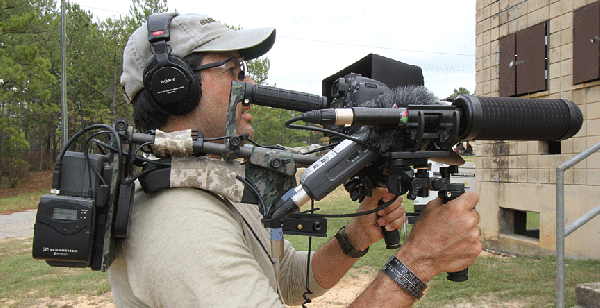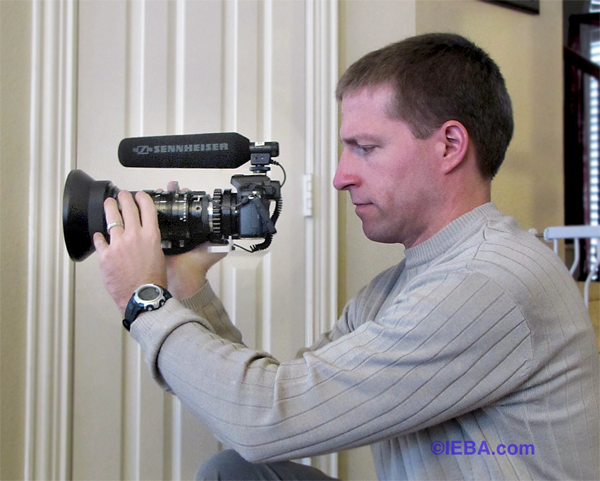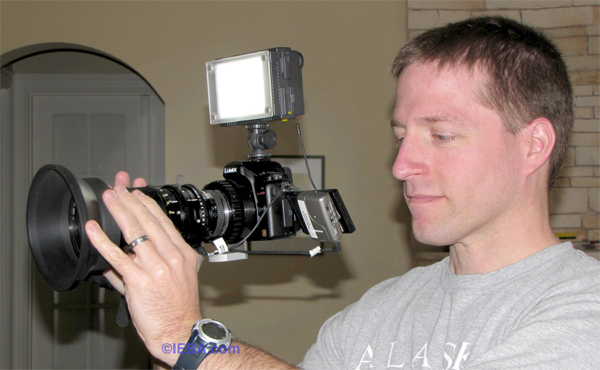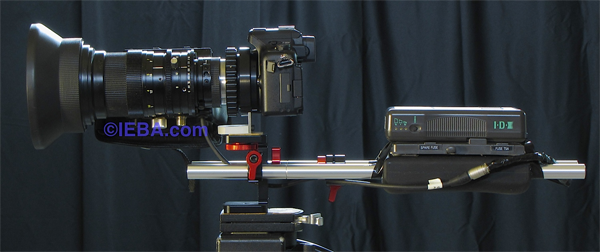Adapting ENG Lenses to DSLR Production, Part 2: Power & Rigging
Adapting servo zoom ENG lenses to your DSLR rig with suitable rails and power makes for a smooth transition from prosumer camcorder to large-sensor video camera.
Why Go to All This Trouble to Put a Video Lens on a Still Camera?
Some feel this is a lot of work to make a camera usable. But those using DSLRs for video are already going far beyond what I am doing here. The "filmic" look, the shallow depth of field, and the low starting costs all make DSLRs a very customizable solution to suit each operator's personal taste. I've long written about how out of hand DSLR rigs can get—sometimes referred to as "frankenrigs."

With two hands holding up the rig, there's no hand to adjust audio, or pull focus.
So many of my regular readers and colleagues in my local production community were very surprised to hear that I was kitting out a DSLR for video. Take into consideration that you can have nearly the convenience of an on-shoulder ENG camcorder, with the "look" and capabilities of a large-sensor camera, and it's easy to understand the appeal, even for the rig-resistant among us. I feel that my "rig" strikes a beautiful balance between a bare DSLR and the frankenrigs by leveraging the advantages of broadcast ENG lenses.

Compact kit with audio. It doesn't get much easier than this.
I recently came across an interesting post about the "kitting out" and "frankenrigging" going on now with DSLRs:
I know your first inclination is to buy as much crap as you can to attach to your new toy, in the form a thousands of dollars worth of goofy aluminum brackets, digital recorders and unnecessarily large shotgun mics, cheap eBay manual lenses and adapters, and unwieldy light panels. Been there. Done that. After something like 3.5 years and hundreds of weddings shooting with 3 GH1 cameras full time, let me tell ya...all you need is a dimmable light. ;) Spend your money on a couple of extra bodies, a couple of the Lumix 20mm f1.7 lenses, a couple Olympus 45mm f1.8 lenses, and decent tripod heads. Digital recorders are dirt cheap for better off-camera audio, captured at the source. Keep it simple, stupid, and guests at the wedding won't laugh at your "rig." That's why I make the big money. :D Good luck!
Truth be told, I got my GH2 on special for $1000 including the 14-140mm lens. Since then, the normal price is $1200 each. By my math, one GH2 and a good ENG lens can be had for under $2000. A good ENG lens will give you a constant f.2, through multiple focal lengths, much like much higher-priced still lenses, and it will also supply smooth servo zoom ability if you want it.
If you'd rather follow his recommendation and buy three still cameras, three lights, and several really good, bright, prime lenses, you'll have much better, buttery, bokeh at f.1.7, but you'll pay 3-5x more than I did, and constantly have to swap lenses or swap between bodies to achieve different focal lengths.
Alternatively, I think one good ENG-DSLR system offers so many benefits:
- Ease of use / handholding balance
- Low f-stop / no f-stop change while zooming
- Small kit / no rigs & rails necessary
- Affordable compared to multiple bodies/primes, or a frankenrig
- That buttery smooth servo zoom when you need it

Here's my ENG-DSLR with wireless mic jacked into the camera and LED light on top.
Compare my compact ENG-DSLR kit with any rig and rails system and you'll see that it's not only a cost-effective solution that continues to provide the advantages that DSLRs inherently offer, but also augments the DSLR with the many advantages of a "camcorder" lens.
Fellow industry writer and Streaming Media Producer contributor Shawn Lam recently ditched all his older gear for two new large sensor camcorders. He summed it up like this:
I love the noise free and true HD resolution that the Super35mm sensor allows. Traditional professional SD video cameras have a trio of square pixel sensors but the move to HD required more resolution, although the sensor sizes didn't increase. As a result, the photo receptors got smaller and new methods of signal processing were required. Small sensor cameras are just too noisy for on-board codecs to preserve both the detail and the noise.
Now, I'll be the first to admit that my GH2 is not as easy to use, especially for audio, as Shawn's FS100 camcorders. But I paid less than 1/5 of the price of the Sony FS100 for my camera, and have already used it successfully on several productions. It's more than paid for itself already. As I refine my new toolset, and become more comfortable with the new workflow, I'll be able to achieve a very good ROI in this tight economy while producing cutting-edge, filmic images for my clients.
What's Next
Now that I know my concept is good, first and foremost, I am looking to upgrade to a HD lens to fully take advantage of the lower f-stops offered by these lenses. As it is now, the chromatic aberration and softness really kicks in under f/2.8. However, now that I know it all works like I imagined, I can upgrade the parts over time. The Tamron was a good $10 eBay investment for finding out how my idea would work. It works wonderfully.
The next development for me would be to utilize the extra pins in the lens cable to toggle recording start and stop on the camera. Now, this connection varies by camera. On the GH2, there's only one remote jack and it's also the audio input. So I hope to either incorporate both the audio input and the REC start/stop on one cable, or I'll have 2 choices: 1, use an external audio recorder--something very common for DSLR use; or 2, continue to record audio in the camera and forgo using the lens to start and stop camera recording.
I also look forward to getting a power adapter to power the camera and the lens from one external lithium-ion battery. I could also power the LED light off that one battery if I so chose. I plan on getting a different camera mount for the rails system, and perhaps a different shoulder pad too, but the smaller-battery solution would also remove the need for an expensive and complicated rig. I can still build something for long-term, on-shoulder shooting to pull the balance back from the camera and onto my shoulder. But much of my work these days is either quick handheld, or I can use a tripod, slider, and so on.

All set up and ready to go. Add a lens remote and a LCD screen and you're even ready for studio work.
As I said, that's the magic of DSLR video. You can set it up to work exactly how you like to work. For me, this makes for a comfortable transition from prosumer handheld camcorder to large-sensor video camera. I fully plan on using primes and other lenses where appropriate and applicable, and having the convenience of this solution for everything else.
Related Articles
DSLRs have become the standard by which current and future large-sensor camcorders are judged. But as we adopted DSLRs and primes to produce more "filmic" video for our clients, we left something critical behind: the feathery smooth servo zoom that serves feature film producers so well. So how do you get that capability on your DSLR?